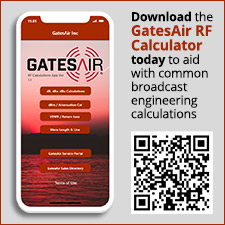.gif)
CENTRE DES MÉDIAS
Nouvelles
Harris Broadcast First to Market with End-to-End Functionality for New ATSC Standards
Solution meets transmitter synchronization requirements across distributed and mobile DTV transmission systems
Denver, CO, February 19, 2013
Harris Broadcast is now shipping the broadcast industry’s first comprehensive solution compliant to the new ATSC standards for transmitter synchronization, ensuring that broadcasters have an all-in-one terrestrial and mobile platform to improve over-the-air signal coverage and maximize viewing audiences.
The ATSC A/110: 2011 specification provides the standards-based solution for ATSC broadcasters to enable single-frequency networks. This allows broadcasters to synchronize over-the-air content across mobile DTV systems and distributed transmission networks that use multiple low-power transmitters within a broadcast market.
Harris Broadcast enables the solution within its Apex M2X™ exciter and Synchrony™ MNA single-frequency network adapter — the only systems currently on the market to offer full compliance. The systems can be used in any Apex M2X-enabled transmitter, including all Harris Broadcast Maxiva™ UHF and Platinum™ VHF models. Existing transmission customers can achieve field upgrades through software downloads from the Harris Broadcast Service Portal at http://harrisbroadcast.com/servicesandsupport/default.asp.
Broadcasters have the flexibility to run standard ATSC DTV systems today, and later add mobile DTV systems or convert to distributed transmission systems. The latter is an emerging trend in the industry, gradually gaining favor with ATSC broadcasters seeking to gain operational efficiencies through lower-cost transmission sites. Distributed transmission systems also ensure that broadcasters can maximize their signal coverage in the event that the impending FCC spectrum repack impacts their current channel assignments.
“As broadcasters look to adopt mobile and consider distributed transmission systems for coverage, the new ATSC specification provides a standards-based path for the user to address one or all of these capabilities,” said Richard Redmond, vice president of product management and strategy, transmission systems, Harris Broadcast. “Our solution offers an open toolbox that allows customers to add and change features, while guaranteeing interoperability among the critical components of a transmission system.”
About Harris Broadcast
Harris Broadcast develops uniquely integrated digital media solutions that streamline the entire content workflow from live production to transmission. The company’s tools and technologies fit seamlessly into any media operation, enabling customers to easily and profitably create compelling content for delivery over multiple distribution platforms. With a presence in key locations around the world, Harris Broadcast supports media customers in more than 130 countries. Additional information is available at www.harrisbroadcast.com.











